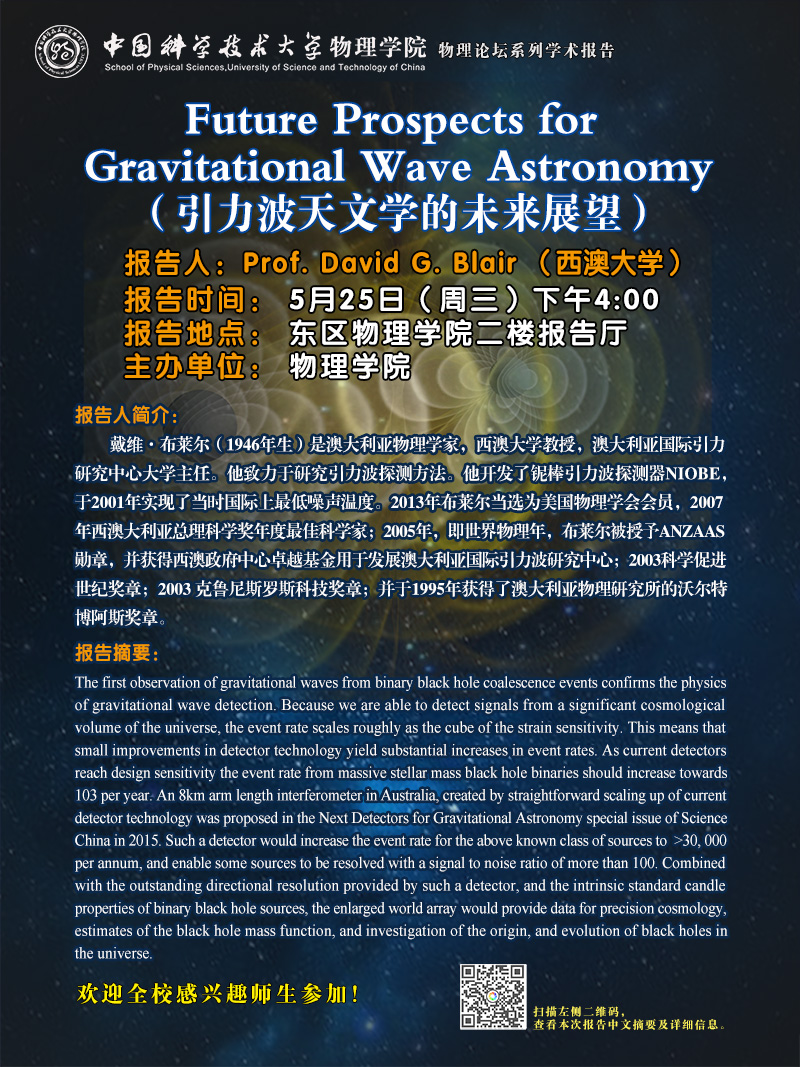报告题目:《Future Prospects for Gravitational Wave Astronomy》(引力波天文学的未来展望) 报告人:Prof. David G. Blair(西澳大学) 报告时间:2016年5月25日(周三)下午4:00 报告地点:物理学院二楼报告厅 报告摘要:The first observation of gravitational waves from binary black hole coalescence events confirms the physics of gravitational wave detection. Because we are able to detect signals from a significant cosmological volume of the universe, the event rate scales roughly as the cube of the strain sensitivity. This means that small improvements in detector technology yield substantial increases in event rates. As current detectors reach design sensitivity the event rate from massive stellar mass black hole binaries should increase towards 103 per year. An 8km arm length interferometer in Australia, created by straightforward scaling up of current detector technology was proposed in the Next Detectors for Gravitational Astronomy special issue of Science China in 2015. Such a detector would increase the event rate for the above known class of sources to >30, 000 per annum, and enable some sources to be resolved with a signal to noise ratio of more than 100. Combined with the outstanding directional resolution provided by such a detector, and the intrinsic standard candle properties of binary black hole sources, the enlarged world array would provide data for precision cosmology, estimates of the black hole mass function, and investigation of the origin, and evolution of black holes in the universe. 来自黑洞双星并合事件产生的引力波信号的首次观测证实了引力波探测的物理过程。由于我们能够从整个宇宙尺度去检测相关信号,这一事件的发生率大致正比于应变灵敏度的立方。这意味着,哪怕探测器技术上很小的进步也会带来观测事例数的大幅提高。根据当前实验所达到的设计灵敏度,来自恒星质量黑洞双星的事例数应该会增至每年约103。2015年,一个在澳大利亚设计开展的8公里臂长的引力波激光干涉仪项目被作为下一代引力波探测实验在《中国科学》的引力天文学专刊中正式提出。这一探测器理论上预期能将已知天体起源的事例发生数增至大约每年30000,并将实现部分观测信噪比高达100。结合这一探测器出色的方向性分辨率与黑洞双星天体源所具备的标准烛光属性,国际上的引力波探测实验阵列将被进一步扩大,为精确宇宙学研究提供更多数据,并将为研究黑洞质量、起源和演化提供有效观测。 报告人简介:David G. Blair (born 1946) is an Australian physicist and professor at the University of Western Australia and Director of the Australian International Gravitational Research Centre. He works on methods for the detection of gravitational waves. He developed the niobium bar gravitational wave detector NIOBE, which achieved the lowest observed noise temperature participated in worldwide collaboration that set the best limit on the burst events in 2001. In 2013 Blair was elected Fellow of the American Physical Society; 2007 Western Australian Premier's Science Award for Scientist of the Year; 2005 World Year of Physics, Blair was awarded the ANZAAS Medal as well as a WA Government Centre of Excellence Grant to develop the Australian International Gravitational Research Centre; 2003 Centenary Medal (for Promotion of Science); 2003 Clunies Ross Medal for Science and Technology; and in 1995 Blair won the Walter Boas Medal of the Australian Institute of Physics. 戴维・布莱尔(1946年生)是澳大利亚物理学家,西澳大利亚教授,澳大利亚国际引力研究中心大学主任。他致力于研究引力波探测方法。他开发了铌棒引力波探测器NIOBE,于2001年实现了当时国际上最低噪声温度。2013年布莱尔当选为美国物理学会会员,2007年西澳大利亚总理科学奖年度最佳科学家;2005年,即世界物理年,布莱尔被授予ANZAAS勋章,并获得西澳政府中心卓越基金用于发展澳大利亚国际引力波研究中心;2003科学促进世纪奖章;2003 克鲁尼斯罗斯科技奖章;并于1995年获得了澳大利亚物理研究所的沃尔特博阿斯奖章。
